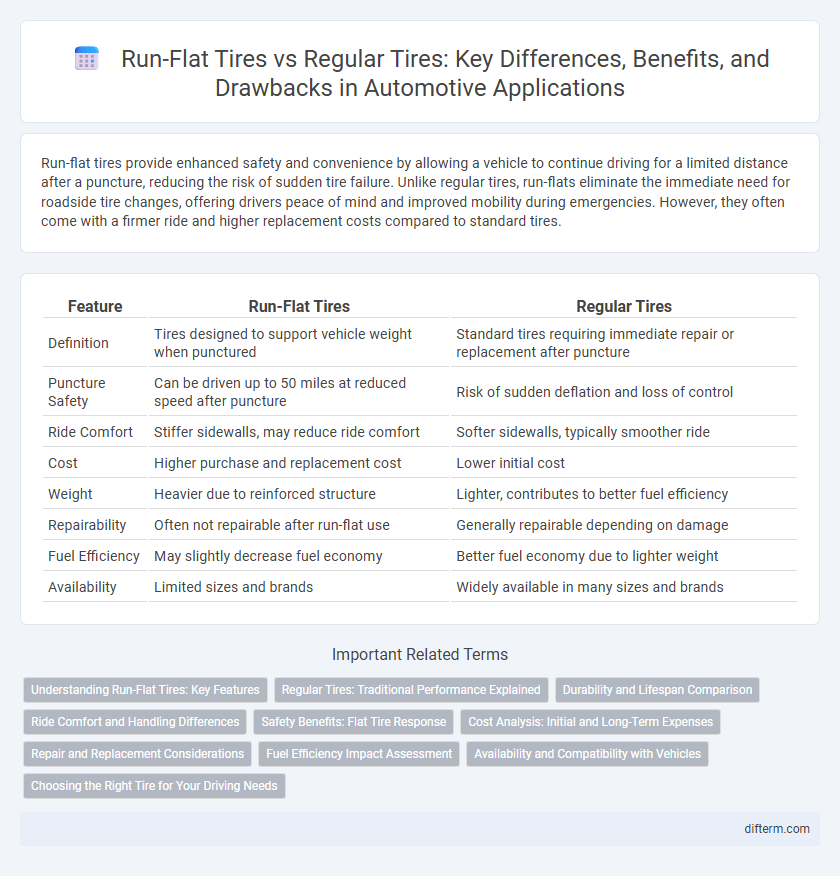Run-flat tires provide enhanced safety and convenience by allowing a vehicle to continue driving for a limited distance after a puncture, reducing the risk of sudden tire failure. Unlike regular tires, run-flats eliminate the immediate need for roadside tire changes, offering drivers peace of mind and improved mobility during emergencies. However, they often come with a firmer ride and higher replacement costs compared to standard tires.
Table of Comparison
| Feature | Run-Flat Tires | Regular Tires |
|---|---|---|
| Definition | Tires designed to support vehicle weight when punctured | Standard tires requiring immediate repair or replacement after puncture |
| Puncture Safety | Can be driven up to 50 miles at reduced speed after puncture | Risk of sudden deflation and loss of control |
| Ride Comfort | Stiffer sidewalls, may reduce ride comfort | Softer sidewalls, typically smoother ride |
| Cost | Higher purchase and replacement cost | Lower initial cost |
| Weight | Heavier due to reinforced structure | Lighter, contributes to better fuel efficiency |
| Repairability | Often not repairable after run-flat use | Generally repairable depending on damage |
| Fuel Efficiency | May slightly decrease fuel economy | Better fuel economy due to lighter weight |
| Availability | Limited sizes and brands | Widely available in many sizes and brands |
Understanding Run-Flat Tires: Key Features
Run-flat tires feature reinforced sidewalls that support the vehicle's weight even after losing air pressure, enabling drivers to continue driving safely for up to 50 miles at reduced speeds. These tires eliminate the immediate need for roadside tire changes and enhance safety during emergency situations. However, run-flats often have stiffer rides and typically require specialized tires and rims, influencing vehicle compatibility and overall performance.
Regular Tires: Traditional Performance Explained
Regular tires feature flexible sidewalls that absorb road impact for a smooth ride, enhancing fuel efficiency compared to run-flat tires. Their lighter construction reduces rolling resistance, contributing to better mileage and handling responsiveness. However, regular tires require immediate repair or replacement after a puncture, lacking the temporary mobility benefit of run-flat designs.
Durability and Lifespan Comparison
Run-flat tires feature reinforced sidewalls that maintain structural integrity even when air pressure is lost, providing enhanced durability compared to regular tires that risk immediate failure under similar conditions. The lifespan of run-flat tires typically ranges from 30,000 to 50,000 miles, slightly less than the average 40,000 to 70,000 miles offered by conventional tires due to stiffer construction and increased wear. Regular tires generally benefit from easier maintenance and widespread availability, but run-flats deliver superior performance during emergencies by allowing continued driving for up to 50 miles at reduced speeds.
Ride Comfort and Handling Differences
Run-flat tires provide enhanced safety by allowing continued driving after a puncture but often sacrifice ride comfort due to stiffer sidewalls that reduce shock absorption. Regular tires typically deliver a smoother ride and better handling dynamics, offering more responsive steering and improved road feedback. The trade-off between run-flat and regular tires largely hinges on prioritizing convenience and safety versus optimal driving comfort and performance.
Safety Benefits: Flat Tire Response
Run-flat tires enhance safety by allowing drivers to maintain control and continue driving up to 50 miles at reduced speeds after a puncture, minimizing the risk of accidents caused by sudden tire deflation. Conventional tires require immediate replacement or repair, often leaving drivers stranded in hazardous locations. The ability of run-flat tires to sustain vehicle stability during a flat tire incident significantly reduces roadside danger and improves overall driving safety.
Cost Analysis: Initial and Long-Term Expenses
Run-flat tires generally have a higher initial purchase price compared to regular tires, often costing 20-30% more per tire due to their reinforced sidewalls and specialized construction. Long-term expenses tend to increase with run-flat tires as they wear faster, typically lasting around 25,000 to 50,000 miles versus 40,000 to 70,000 miles for regular tires, leading to more frequent replacements. While regular tires may require a spare tire and associated maintenance costs, run-flat tires eliminate this need, partially offsetting the higher upfront and replacement prices in total cost of ownership.
Repair and Replacement Considerations
Run-flat tires allow drivers to continue driving up to 50 miles at reduced speeds after a puncture, reducing immediate roadside repair needs but requiring specialized repair shops with compatible equipment. Regular tires often need immediate replacement or repair by common tire services, providing more widespread and affordable maintenance options. The higher cost and limited repairability of run-flat tires make replacement considerations essential when evaluating long-term vehicle maintenance expenses.
Fuel Efficiency Impact Assessment
Run-flat tires generally increase rolling resistance compared to regular tires, leading to slightly lower fuel efficiency in passenger vehicles. The added weight and stiffer sidewalls of run-flat tires contribute to increased fuel consumption, often reducing miles per gallon by approximately 1-2%. However, advancements in tire technology continue to narrow this efficiency gap, making modern run-flat tires more comparable to regular tires in terms of fuel economy.
Availability and Compatibility with Vehicles
Run-flat tires are increasingly available across various automotive brands but remain limited compared to regular tires, which dominate the market with widespread availability. Run-flat tires require vehicles equipped with reinforced sidewalls and compatible tire pressure monitoring systems (TPMS) to ensure safe operation, restricting their use to specific car models, mainly luxury and performance vehicles. Regular tires offer broader compatibility with nearly all vehicles, including economy and mid-range models, without the need for specialized equipment.
Choosing the Right Tire for Your Driving Needs
Run-flat tires provide enhanced safety by allowing temporary continued driving after a puncture, making them ideal for urban environments and long-distance travelers who prioritize convenience and emergency resilience. Regular tires offer a wider range of options in price, performance, and ride comfort, suitable for drivers focused on cost-efficiency and handling on varied road surfaces. Assessing driving habits, vehicle type, and maintenance preferences ensures selection of tires that balance safety, performance, and overall cost-effectiveness for daily use.
run-flat tires vs regular tires Infographic

 difterm.com
difterm.com